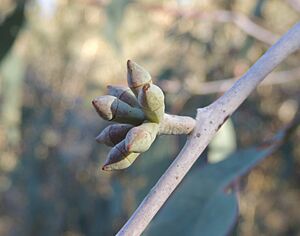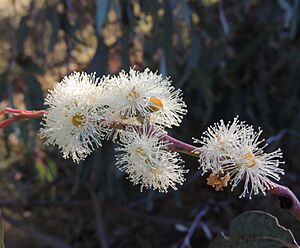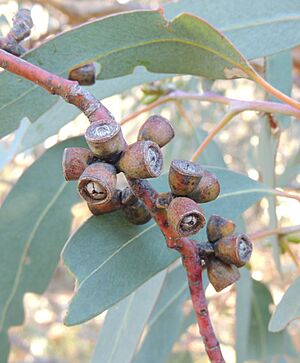Bundy facts for kids
Quick facts for kids Bundy |
|
|---|---|
 |
|
| Eucalyptus nortonii on Mount Ainslie | |
| Scientific classification | |
| Genus: |
Eucalyptus
|
| Species: |
nortonii
|
| Synonyms | |
The Eucalyptus nortonii, often called bundy, mealy bundy, or long-leaved box, is a type of small tree. It is found only in south-eastern Australia. This tree has rough, thick bark on its main trunk and bigger branches. Its thinner branches have smooth, grey bark. It has long, lance-shaped leaves, and its flower buds grow in groups of seven. The flowers are white, and the fruit looks like a cup or cylinder.
Contents
What Does the Bundy Tree Look Like?
The Eucalyptus nortonii tree usually grows to be about 15 to 18 meters (50 to 60 feet) tall. It has a special woody swelling at its base called a lignotuber. This helps the tree regrow after fires.
Bark and Leaves
The bark on the main trunk and larger branches is rough and thick. It can be fibrous or flaky. The very thinnest branches sometimes have smooth, grey bark.
Young bundy plants and new shoots (called coppice regrowth) have a bluish-white coating, which is known as being glaucous. Their leaves are heart-shaped or round. These young leaves are 25 to 90 mm (1 to 3.5 inches) long and 30 to 80 mm (1 to 3 inches) wide. They grow directly on the stem without a stalk, which means they are sessile. They are also arranged in opposite pairs.
Adult leaves are a dull bluish or greyish-green color on both sides. They are quite long, from 85 to 300 mm (3.3 to 11.8 inches), and 15 to 40 mm (0.6 to 1.6 inches) wide. These leaves narrow down to a stalk called a petiole, which is 14 to 40 mm (0.6 to 1.6 inches) long.
Flowers and Fruit
The flower buds grow in groups of seven in the leaf axils (where the leaf meets the stem). Each group of buds grows on a single stalk, called a peduncle, which is 4 to 13 mm (0.2 to 0.5 inches) long. Some individual buds have very short stalks, up to 2 mm long, called pedicels.
Mature buds are oblong or oval shaped. They are 7 to 13 mm (0.3 to 0.5 inches) long and 3 to 6 mm (0.1 to 0.2 inches) wide. They have a cone-shaped cap called an operculum.
Bundy trees mostly flower from January to April. Their flowers are white. After flowering, the tree produces woody fruit. This fruit is a cup-shaped or cylindrical capsule. It is 5 to 9 mm (0.2 to 0.4 inches) long and 5 to 7 mm (0.2 to 0.3 inches) wide. The parts that open to release seeds are near the rim of the fruit.
How the Bundy Tree Got Its Name
The bundy tree was first officially described in 1934 by a person named William Blakely. He gave it the name Eucalyptus × cordieri var. nortonii. He wrote about it in his book, A Key to the Eucalypts.
The first samples of the tree were collected by a beekeeper named Alfred Ernest Norton. He found them near a place called Nundle. Later, in 1962, another scientist named Lawrie Johnson changed the tree's name to E. nortonii, honoring Alfred Norton.
Where Does the Bundy Tree Grow?
The Eucalyptus nortonii tree is found in many places across south-eastern Australia. It is common in open woodlands. You can find it on dry, rocky areas of the tablelands in New South Wales and the Australian Capital Territory. It grows south from a town called Manilla.
It also grows in central and eastern Victoria. This includes areas near Suggan Buggan and Whitfield. You can also find it from Castlemaine all the way to the Pyrenees mountain range in Victoria.




